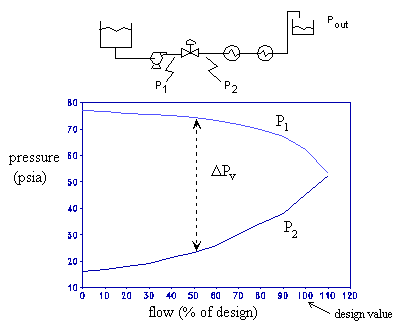| 3.0 Control Valves |
The most common method for influencing the behavior of chemical processes is through the flow rate of process streams. Usually, a variable resistance in the closed conduit or pipe is manipulated to influence the flow rate and achieve the desired process behavior. A valve with a variable opening for flow is the standard equipment used to introduce this variable resistance; the valve is selected because it is simple, reliable, relatively low cost and available for a wide range of process applications. In some cases the valve resistance is set by a person adjusting the opening, like a home faucet. In many cases the valve resistance is determined by an automatic controller, with the valve designed to accept and implement the signal sent from the controller. These are control valves. A multitude of commercial control valves are available; so the goal of this section is to describe the key features of common valves and provide guidance on proper selection and sizing.
The
principles of flow control through a restriction in a pipe are
presented in textbooks on fluid mechanics (e.g., Janna, 1993) and are
briefly summarized here with reference to the example system in Figure
7 taken from Marlin (2000). Naturally, the total pressure
drop along the pipe after the valve is the sum of the individual
pressure drops, as given in the following equation.
|
Total pressure drop relationship for pressure downstream of the valve |
|
(7) |
As we know the resistance to fluid flow increases as the flow rate increases. Also, the source of the high pressure, here a pump, may be influenced by the flow rate; in this case, the pump head decreases as the flow increases. The relationship between the pressures at the inlet and exit of the valve are shown in Figure 7, and the required pressure drop across the valve is shown as DPv. Therefore, any desired flow from 0 to 110% of the design valve can be achieved by adjusting the valve opening to provide the required resistance to flow, DPv. For the example in Figure 7, when the flow is 80% of design, the valve pressure drop is about 40 psi, which can be achieved by adjusting the valve opening for flow to the proper value.

Figure 7. Example flow network with valve pressure drop.
Note that energy is required to raise the stream pressure to P1
is "lost energy". Therefore, efficient design minimizes the
valve pressure drop while providing sufficient variable resistance for
good flow regulation. Theoretically, a control valve would not
be needed if the supply pressure, in Figure 7 this is P1,
could be varied. Variable speed electrical motors to drive
pumps are available for liquid systems, but the added cost and lower
efficiencies of these pumps has resulted in the control valve remaining
the standard choice for regulating liquid flow (Bauman,
1981). Variable speed steam turbines to drive compressors are
commonly applied for gas systems; thus, two methods for adjusting flow
in gas systems are common in the process industries: these are:
manipulating the supply pressure (by the speed of the compressor or pump) and
manipulating the variable flow resistance (by a control valve).
We will concentrate on control valves, which are the overwhelming choice for flow control in the process industries.
| To view a video giving a short introduction to control valves, including discussions of rotary and linear valves, select this button. |